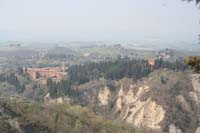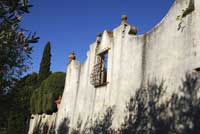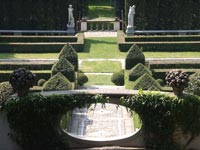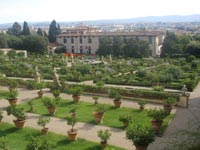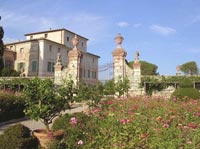 |
| View of Arcetri area (in the hills above Florence)
|
Villa La Gallina in Arcetri |
Arcetri is a district of Florence, in the hills to the south of the city centre. A number of historic buildings are situated there, including the house of the famous scientist Galileo Galilei (called Villa il Gioiello), the Convent of San Matteo and the Torre del Gallo. The Osservatorio Astrofisico di Arcetri is also located here. The church of San Leonardo in Arcetri is the main church of the area. |
|
||
Villa La Gallina
|
||
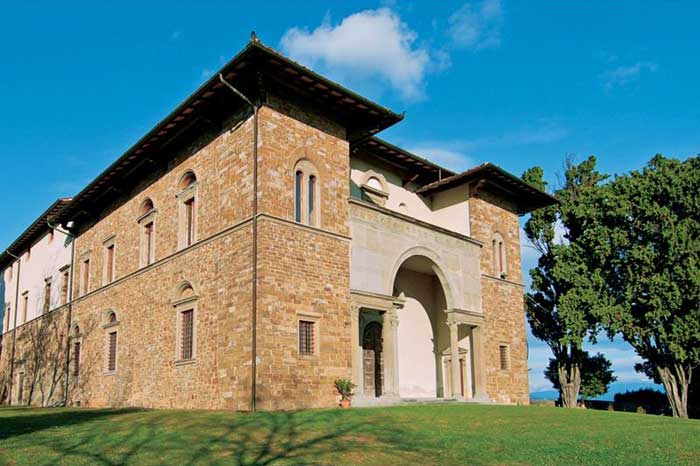 |
||
Villa La Gallina in Arcetri
|
||
| Surrounded by cypress and olive trees and offering breathtaking 360-degree views of the city, Villa La Gallina sits on a hilltop just above Piazzale Michelangelo. The estate dates back to the beginning of the 15th Century, with the last major restoration performed in 2005 by the current owners. The property is actually the front section of a former castle that originally belonged to friends of Lorenzo de’ Medici, who commissioned the home’s renowned Danza dei nudi. This is one of only a handful of surviving frescoes created by the Renaissance master Antonio del Pollaiuolo, and its timeless elegance graces one of the main floor’s salons. Inside, much of the original architectural detail remains intact, from the stone door and window frames, to the double-height coffered ceilings and carved columns of old Tuscan stone.
|
||
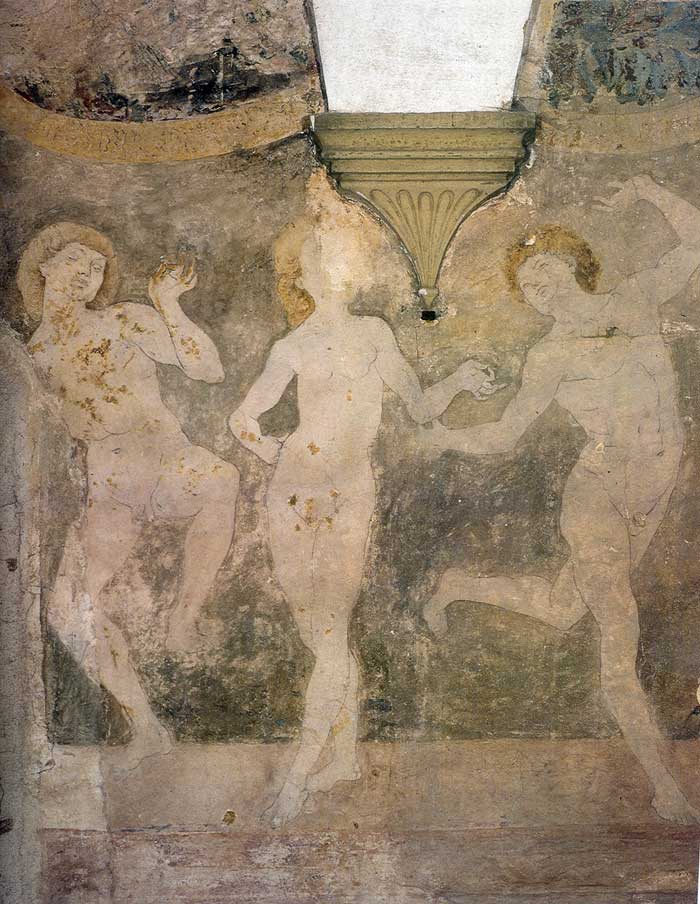 |
||
| The damaged fresco painting of the frenetic Dancing Nudes in the Villa la Gallina near Florence, reveals his fanatical interest in the nude in action. Pollaiuolo also executed one engraving, the famous Battle of the Nudes (ca. 1465). It is a masterful synthesis of his main artistic ideal: the decorative beauty, in violent posturings, of the male nude. |
||
|
||
|
||||
[1] Antonio del Pollaiuolo (Italian,1431 –1498) was a renowned Florentine painter, sculptor, draftsman, and goldsmith who was particularly admired for his dynamic and expressive portrayal of the human figure. He carried out a wide range of projects including a series of Hercules paintings (now lost) for the powerful Medici family in Florence, designs for embroidered vestments, monumental tombs for Popes Sixtus IV and Innocent VIII in St.Peter’s Basilica in Rome, small bronze sculptures, and reliefs. The Florentine brothers Antonio and Piero del Pollaiuolo were born some 10 years apart and started on different paths. Antonio trained as a goldsmith, and as a sculptor in the Ghiberti workshop. Piero trained as a painter, perhaps with Andrea dal Castagno. Antonio is usually considered the greater artist; he developed design skills which were the basis of the painting and sculpture for which he was famous. Antonio had his own workshop by 1459 and styled himself painter and sculptor. He was, and remains, famous for his work in other media such as designs for embroidery, engraving and enamel-work. His engraving of the 'Battle of the Ten Nudes' was the largest and most influential print of the 15th century, providing models of the male body in action. The name Pollaiuolo means 'poulterer', which was the occupation of their father, Jacopo di Giovanni Benci. |
||||
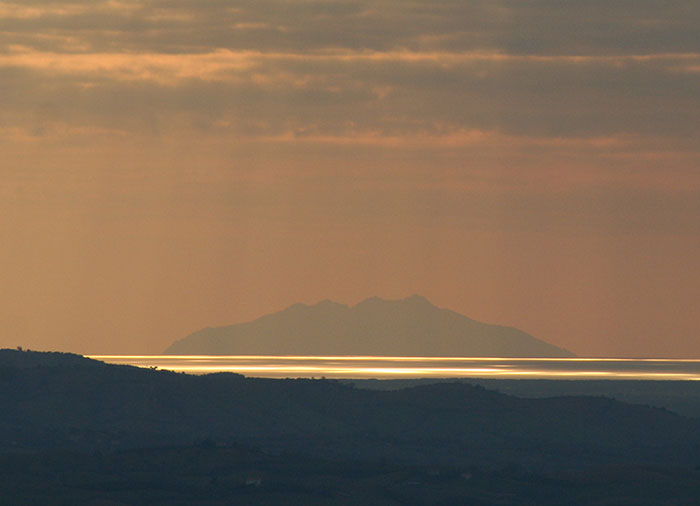 |
||||
Hidden secrets in Tuscany | Holiday house Podere Santa Pia |
||||
Podere Santa Pia |
Podere Santa Pia, view from the garden on the valley below |
Monte Oliveto Maggiore abbey |
||
Via del Pian dei Giullari |
||||
| The Villa Capponi garden, commented upon by Edith Wharton and Geoffrey Jellicoe, dates from the seventeenth century. It was extended by Lady Elizabeth Scott after 1882 and by Cecil Ross Pinsent after 1939. Surrounded by steep slopes of vineyards and olive groves, it has that Tuscan combination of architectural refinement within an ordered agricultural setting which exudes an air of dignity and domestic repose. Cecil Ross Pinsent was an English architect who designed and built Tuscan villas and gardens for the English speaking community in Tuscany between 1910 and 1940. He visited Florence with his friend Geoffrey Scott on a tour of Tuscan architecture. Scott became librarian to the American art historian Bernard Berenson and Pinsent worked with him on the Villa I Tatti in Settignano. This provided an entree to a wealthy circle of clients, including Charles Augustus Strong, Alice Keppel and Lady Sybil Cutting. Villa Capponi, built in the 14th century, was purchased in 1572 by the Capponi family which extended it and enhanced it, turning it into a noble residence. In 1882 it became the property of Lady Scott, daughter of the Duke of Portland, and later passed into the hands of the Clifford family. The building, which is quite simple in layout, was further embellished at the end of the 19th century with the additions of two panoramic loggias, the columns for which were, it seems, taken from demolition work done during the redevelopment of the old city centre to create Piazza della Repubblica. The garden, which comprises terraces on different levels, extends along the Pian dei Giullari hillside, from where the view over Florence is quite breathtaking, and blends in with the surrounding farmland. The first terrace, immediately behind the villa, is a broad grassy area stretching the length of the northern side of the building, on which an ancient wisteria hangs. To the east, on the same level, is the entrance to a delightful secret garden, rectangular in layout and edged in box hedges. Access to this formal garden, separated from the lawn by another box hedge, is marked by two columns surmounted by two terracotta griffins. To the west, on different levels, are another two secret gardens with box-edged parterres and surrounded by high walls with elegantly curving crenellations and earthenware urns. The first of these gardens, which lies five metres lower than the level of the villa, is reached by a narrow flight of steps beside the boundary wall. A wrought-iron gate leads to the second garden, at the centre of which stands a fine stone lily-pool. The recently-built rectangular swimming pool lower down is surrounded by tall rows of cypresses.[Source: Firenze - Villa Capponi | www.cultura.toscana.it] Gardens in Tuscany | Villa Capponi Garden Address - Pian dei Giullari, 4, Firenze. |
||||
|
||||
| Villa il Gioiello ("The Jewel") is a villa in Florence, central Italy, famous for being one of the residences of Galileo Galilei, which he lived in from 1631 until his death in 1642. It is also known as Villa Galileo (not to be confused with the other homes of Galileo found in Florence, which are in Costa San Giorgio, as well as a villa in Bellosguardo). The name Gioiello was given due to its favorable position in the hills of Arcetri, near the Torre del Gallo. It was an elegant home, surrounded by many acres of farmland with a separate house for workers. It is recorded in the cadastre of 1427 to have been owned by Tommaso di Cristofano Masi and his brothers, who later passed it on to the Calderini family in 1525, where it is first mentioned as "The Jewel". The villa and its estate suffered damages during the siege of Florence in the years 1529 and 1530, whilst the entire area of Arcetri and Pian dei Giullari were occupied by Imperial troops. Calderini I sold it shortly thereafter to the Cavalcanti family, who rebuilt the home with its original simple lines, preserving its elegant look to the present day. This rented residence with its fields, adjoined the monastery where his daughter, Sister Maria Celeste (born Virginia) was a nun. There are 124 remaining letters from Celeste to Galileo (the replies of the scientist were probably destroyed) which were filed after his death (at the State Archive of Florence) in the inventory of property owned by Galileo. Galileo's books are now held in the Biblioteca Nazionale Centrale di Firenze and are the subject of a celebratory exhibit: Galileiana 2009. Galileo lived there after his abjuration (1633) and was put under house arrest. Despite becoming blind in 1638, he continued to write some of his most significant works. In 1634 he suffered the loss of his favorite daughter, Celeste, but continued to work on Discourses and Mathematical Demonstrations Relating to Two New Sciences (Discorsi e Dimostrazioni Matematiche, intorno a due nuove scienze), in which he presented his theories on the strength and resistance of materials and on motion. Shortly after Galileo moved to Arcetri, he received visits from Ferdinando II de' Medici as well as the painter Giusto Sustermans, who painted a portrait of the famous scientist. Other guests were the Ambassador of the Netherlands (Galileo had printed many of his books in Leiden) and the English poet John Milton. He made frequent visits to the students of Villa Castelli, and the young Vincenzo Viviani and Evangelista Torricelli assisted Galileo until his death. In the centuries thereafter, the house has had various owners: the Del Soldato Family, whose coat of arms is on the facade, and even the nuns of St. Matthew, for which Mr. Otto adorned a plaque on the facade prohibiting “any card or ball game, ruzzola, or any other kind of game" with severe penalties if caught. In 1788 Senator Clemente Nelli had affixed a plaque dedicated to Galileo on the facade, and in 1843 a bust of the scientist was placed in a niche by the owners. In the 19th century, the building underwent further changes, especially on the upper floor. Villa il Goiello has been a national monument since 1920 and was in private hands until 1942, when it was purchased by the state. Today, it belongs to the Department of Astronomy at the University of Florence, and has undergone a long restoration process since 1986; just recently ending in 2008. It was scheduled to re-open to the public during the celebration of Galeleiano in 2009. The project had foreseen the creation of a "City of Galileo", which also included the Astrophysical Observatory at Arcetri and the Torre del Gallo with annexes, but the project has been suspended and is now under reconsideration. The villa is in the form of a "U", which encompasses the central courtyard, enclosed by a wall on the street side, facing the farmhouse. The courtyard has a loggia, supported by arch-less Tuscan columns. The facade on the street is very simple, with some rectangular windows with stone frames. Here you will find the bust of the astronomer, with inscription (1843), and another plaque placed in 1942. |
||||
* San Leonardo in Arcetri (Church of Saint Leonard) * San Matteo in Arcetri * Osservatorio Astrofisico di Arcetri (Astrophysical Observatory) * Pian dei Giullari (Square of Giullari) * Villa Capponi * Villa Il Giullarino * Villa di Volsanminiato * Torre del Gallo (Tower of the Cockerell) * Villa La Gallina * Villa Agape-Arrighetti * Villa Giramonte * Villa Giovannelli * Villa Nunes Vais * Villa Il Teatro * Villa Pian dei Giullari * Villa Masieri * Villa Il Gioiello * Villa Le Corti * Villa Pazzi * Villa Ravà * Villa Il Roseto * Fondazione Spadolini * Monteripaldi * San Michele a Monteripaldi * Santa Margherita a Montici (Church of Saint Margaret at Montici)
|
||||
Villa I Tatti |
Parco di Villa Reale di Castello (Villa di Castello) in Florence |
|||



